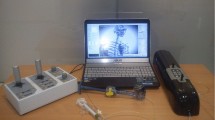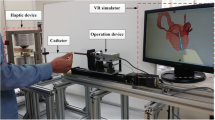Abstract
Endovascular robotic systems have been applied in robot-assisted interventional surgery to improve surgical safety and reduce radiation to surgeons. However, this surgery requires surgeons to be highly skilled at operating vascular interventional surgical robot. Virtual reality (VR) interventional training systems for robot-assisted interventional surgical training have many advantages over traditional training methods. For virtual interventional radiology, simulation of the behaviors of surgical tools (here mainly refers to catheter and guidewire) is a challenging work. In this paper, we developed a novel virtual reality interventional training system. This system is an extension of the endovascular robotic system. Because the master side of this system can be used for both the endovascular robotic system and the VR interventional training system, the proposed system improves training and reduces the cost of education. Moreover, we proposed a novel method to solve catheterization modeling during the interventional simulation. Our method discretizes the catheter by the collision points. The catheter between two adjacent collision points is treated as thin torsion-free elastic rods. The deformation of the rod is mainly affected by the force applied at the collision points. Meanwhile, the virtual contact force is determined by the collision points. This simplification makes the model more stable and reduces the computational complexity, and the behavior of the surgical tools can be approximated. Therefore, we realized the catheter interaction simulation and virtual force feedback for the proposed VR interventional training system. The performance of our method is experimentally validated.
Graphical Abstract
















Similar content being viewed by others
References
Shi P, Guo S, Zhang L, Jin X, Hirata H, Tamiya T, Kawanishi M (2021) Design and evaluation of a haptic robot-assisted catheter operating system with collision protection function. IEEE Sens J 21(18):20807–20816. https://doi.org/10.1109/JSEN.2021.3095187
Guo S, Song Y, Yin X, Zhang L, Tamiya T, Hirata H, Ishihara H (2019) A novel robot-assisted endovascular catheterization system with haptic force feedback. IEEE Trans Rob 35(3):685–696. https://doi.org/10.1109/TRO.2019.2896763
Yin X, Guo S, Xiao N, Tamiya T, Hirata H, Ishihara H (2016) Safety operation consciousness realization of a MR fluids-based novel haptic interface for teleoperated catheter minimally invasive neurosurgery. IEEE/ASME Trans Mechatron 21(2):1043–1054. https://doi.org/10.1109/TMECH.2015.2489219
Bao X, Guo S, Xiao N, Li Y, Shi L (2018) Compensatory force measurement and multimodal force feedback for remote-controlled vascular interventional robot. Biomed Microdevice 20(3):74. https://doi.org/10.1007/s10544-018-0318-0
Song Y, Guo S, Yin X, Zhang L, Hirata H, Ishihara H, Tamiya T (2018) Performance evaluation of a robot-assisted catheter operating system with haptic feedback. Biomed Microdevice 20(2):50. https://doi.org/10.1007/s10544-018-0294-4
Zhao Y, Guo S, Wang Y, Cui J, Ma Y, Zeng Y, Liu X, Jiang Y, Li Y, Shi L, Xiao N (2019) A CNN-based prototype method of unstructured surgical state perception and navigation for an endovascular surgery robot. Med Biol Eng Compu 57(9):1875–1887. https://doi.org/10.1007/s11517-019-02002-0
Yang C, Guo S, Bao X, Xiao N, Shi L, Li Y, Jiang Y (2019) A vascular interventional surgical robot based on surgeon’s operating skills. Med Biol Eng Compu 57(9):1999–2010. https://doi.org/10.1007/s11517-019-02016-8
Zheng L, Guo S (2021) A magnetorheological fluid-based tremor reduction method for robot-assisted catheter operating system. Int J Mechatronics Automation 8(2):72–79. https://doi.org/10.1504/IJMA.2021.115234
Sankaran NK, Chembrammel P, Siddiqui A, Snyder K, Kesavadas T (2018) Design and development of surgeon augmented endovascular robotic system. IEEE Trans Biomed Eng 65(11):2483–2493. https://doi.org/10.1109/TBME.2018.2800639
Wang H, Wu J, Cai Y (2019) An adaptive deviation-feedback approach for simulating multiple devices interaction in virtual interventional radiology. Comput Aided Des 117:102738. https://doi.org/10.1016/j.cad.2019.102738
Wang Y, Serracino-Inglott F, Yi X, Yuan X-F, Yang X-J (2016) Real-time simulation of catheterization in endovascular surgeries. Comput Animation Virtual Worlds 27(3–4):185–194. https://doi.org/10.1002/cav.1702
Nowinski WL, Chui C-K (2001) Simulation of interventional neuroradiology procedures. Proceed Int Workshop Med Imaging Augmented Reality, 87–94https://doi.org/10.1109/MIAR.2001.930269
Duriez C, Cotin S, Lenoir J, Neumann P (2006) New approaches to catheter navigation for interventional radiology simulation. Comput Aided Surg 11(6):300–308. https://doi.org/10.3109/10929080601090623
Li S, Guo J, Wang Q, Meng Q, Chui Y, Qin J, Heng P (2012) A catheterization-training simulator based on a fast multigrid solver. IEEE Comput Graphics Appl 32(6):56–70. https://doi.org/10.1109/MCG.2012.32
Li S, Qin J, Guo J, Chui Y-P, Heng P-A (2011) A novel FEM-based numerical solver for interactive catheter simulation in virtual catheterization. Int J Biomed Imaging 2011:815246. https://doi.org/10.1155/2011/815246
Alderliesten T, Bosman PAN, Niessen WJ (2007) Towards a real-time minimally-invasive vascular intervention simulation system. IEEE Trans Med Imaging 26(1):128–132. https://doi.org/10.1109/TMI.2006.886814
Alderliesten T, Konings MK, Niessen WJ (2007) Modeling friction, intrinsic curvature, and rotation of guide wires for simulation of minimally invasive vascular interventions. IEEE Trans Biomed Eng 54(1):29–38
Luboz V, Blazewski R, Gould D, Bello F (2009) Real-time guidewire simulation in complex vascular models. Vis Comput 25(9):827–834. https://doi.org/10.1007/s00371-009-0312-x
Luboz V, Zhang Y, Johnson S, Song Y, Kilkenny C, Hunt C, Woolnough H, Guediri S, Zhai J, Odetoyinbo T, Littler P, Fisher A, Hughes C, Chalmers N, Kessel D, Clough PJ, Ward J, Phillips R, How T, … Gould D (2013). ImaGiNe Seldinger: First simulator for Seldinger technique and angiography training. Computer Methods and Programs in Biomedicine, 111(2), 419–434https://doi.org/10.1016/j.cmpb.2013.05.014
Alderliesten T, Konings MK, Niessen WJ (2004) Simulation of minimally invasive vascular interventions for training purposes. Comput Aided Surg 9(1–2):3–15. https://doi.org/10.3109/10929080400006408
Tran PT, Smoljkic G, Gruijthuijsen C, Reynaerts D, Sloten JV, Poorten EV (2016) Position control of robotic catheters inside the vasculature based on a predictive minimum energy model. 2016 IEEE Int Conference Syst, Man, Cybernetics (SMC), 4687–4693. https://doi.org/10.1109/SMC.2016.7844971
Guo J, Guo S (2017) Design and characteristics evaluation of a novel VR-based robot-assisted catheterization training system with force feedback for vascular interventional surgery. Microsyst Technol 23(8):3107–3116. https://doi.org/10.1007/s00542-016-3086-x
Gao B, Guo S, Xiao N, Guo J, Xiao X, Yang S, Qu M (2012) Construction of 3D vessel model of the VR robotic catheter system. IEEE Int Conference Inform Automation 2012:783–788. https://doi.org/10.1109/ICInfA.2012.6246925
Guo J, Guo S (2014) A haptic interface design for a VR-based unskilled doctor training system in vascular interventional surgery. IEEE Int Conference Mechatronics Automation 2014:1259–1263. https://doi.org/10.1109/ICMA.2014.6885880
Guo J, Guo S, Tamiya T, Hirata H, Ishihara H (2016) A virtual reality-based method of decreasing transmission time of visual feedback for a tele-operative robotic catheter operating system. Int J Med Robot Comput Assisted Surg 12(1):32–45. https://doi.org/10.1002/rcs.1642
Wang Y, Yang F, Li Y, Yang T, Ren C, Shi Z (2020) A tactile sensation assisted VR catheterization training system for operator’s cognitive skills enhancement. IEEE Access 8:57180–57191. https://doi.org/10.1109/ACCESS.2020.2982219
Yin X, Guo S, Wang Y (2015) Force model-based haptic master console design for teleoperated minimally invasive surgery application. IEEE Int Conference Mechatronics Automation (ICMA) 2015:749–754. https://doi.org/10.1109/ICMA.2015.7237579
Aydin A, Raison N, Khan MS, Dasgupta P, Ahmed K (2016) Simulation-based training and assessment in urological surgery. Nat Rev Urol 13(9):503–519. https://doi.org/10.1038/nrurol.2016.147
Bergou M, Wardetzky M, Robinson S, Audoly B, Grinspun E. (2008). Discrete elastic rods. In ACM SIGGRAPH 2008 papers (pp. 1–12).
Shi P, Guo S, Jin X, Li X (2021) Centerline Extraction Method for virtual vascular model in virtual reality interventional training systems. IEEE Int Conference Mechatronics Automation (ICMA) 2021:1060–1064. https://doi.org/10.1109/ICMA52036.2021.9512807
Jin X, Guo S, Guo J, Shi P, Tamiya T, Hirata H (2021) Development of a tactile sensing robot-assisted system for vascular interventional surgery. IEEE Sens J 21(10):12284–12294. https://doi.org/10.1109/JSEN.2021.3066424
Jin X, Guo S, Guo J, Shi P, Tamiya T, Kawanishi M, Hirata H (2021) Total force analysis and safety enhancing for operating both guidewire and catheter in endovascular surgery. IEEE Sens J 21(20):22499–22509. https://doi.org/10.1109/JSEN.2021.3107188
Zhang L, Guo S, Yu H, Song Y (2017) Performance evaluation of a strain-gauge force sensor for a haptic robot-assisted catheter operating system. Microsyst Technol 23(10):5041–5050. https://doi.org/10.1007/s00542-017-3380-2
Zhang L, Guo S, Yu H, Song Y, Tamiya T, Hirata H, Ishihara H (2018) Design and performance evaluation of collision protection-based safety operation for a haptic robot-assisted catheter operating system. Biomed Microdevice 20(2):22. https://doi.org/10.1007/s10544-018-0266-8
Bao X, Guo S, Xiao N, Li Y, Yang C, Shen R, Cui J, Jiang Y, Liu X, Liu K (2018) Operation evaluation in-human of a novel remote-controlled vascular interventional robot. Biomed Microdevice 20(2):34. https://doi.org/10.1007/s10544-018-0277-5
Bao X, Guo S, Xiao N, Li Y, Yang C, Jiang Y (2018) A cooperation of catheters and guidewires-based novel remote-controlled vascular interventional robot. Biomed Microdevice 20(1):20. https://doi.org/10.1007/s10544-018-0261-0
Guo J, Jin X, Guo S, Fu Q (2019) A vascular interventional surgical robotic system based on force-visual feedback. IEEE Sens J 19(23):11081–11089
Kosinski RJ (2008) A literature review on reaction time. Clemson Univ 10(1):337–344
Acknowledgements
This work was supported in part by the National High-Tech Research and Development Program (863 Program) of China under Grant 2015AA043202, and in part by SPS KAKENHI under Grant 15K2120.
Author information
Authors and Affiliations
Corresponding author
Additional information
Publisher's note
Springer Nature remains neutral with regard to jurisdictional claims in published maps and institutional affiliations.
Rights and permissions
Springer Nature or its licensor (e.g. a society or other partner) holds exclusive rights to this article under a publishing agreement with the author(s) or other rightsholder(s); author self-archiving of the accepted manuscript version of this article is solely governed by the terms of such publishing agreement and applicable law.
About this article
Cite this article
Shi, P., Guo, S., Jin, X. et al. A novel catheter interaction simulating method for virtual reality interventional training systems. Med Biol Eng Comput 61, 685–697 (2023). https://doi.org/10.1007/s11517-022-02730-w
Received:
Accepted:
Published:
Issue Date:
DOI: https://doi.org/10.1007/s11517-022-02730-w




